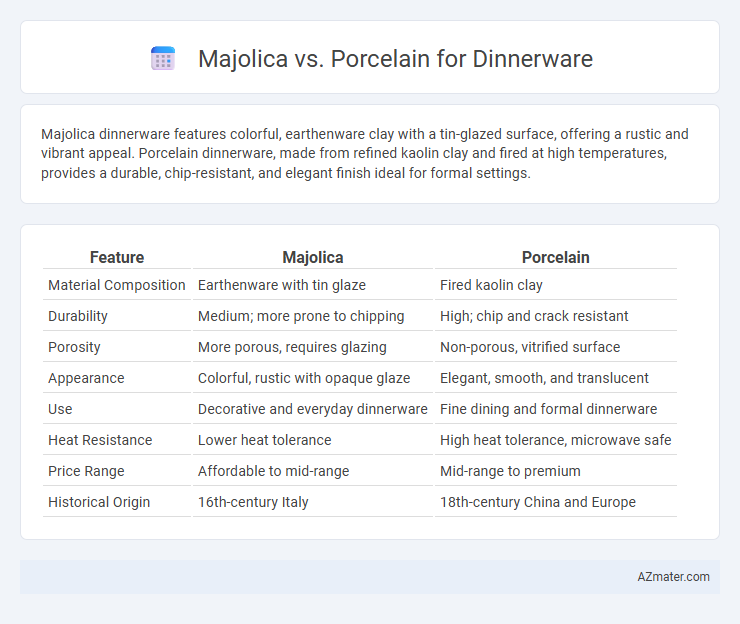Majolica dinnerware features colorful, earthenware clay with a tin-glazed surface, offering a rustic and vibrant appeal. Porcelain dinnerware, made from refined kaolin clay and fired at high temperatures, provides a durable, chip-resistant, and elegant finish ideal for formal settings.
Table of Comparison
| Feature | Majolica | Porcelain |
|---|---|---|
| Material Composition | Earthenware with tin glaze | Fired kaolin clay |
| Durability | Medium; more prone to chipping | High; chip and crack resistant |
| Porosity | More porous, requires glazing | Non-porous, vitrified surface |
| Appearance | Colorful, rustic with opaque glaze | Elegant, smooth, and translucent |
| Use | Decorative and everyday dinnerware | Fine dining and formal dinnerware |
| Heat Resistance | Lower heat tolerance | High heat tolerance, microwave safe |
| Price Range | Affordable to mid-range | Mid-range to premium |
| Historical Origin | 16th-century Italy | 18th-century China and Europe |
Introduction to Majolica and Porcelain
Majolica is a tin-glazed pottery known for its vibrant, opaque surface and decorative hand-painted designs, making it a popular choice for colorful, artisanal dinnerware. Porcelain features a translucent, white, and highly durable ceramic body fired at high temperatures, valued for its elegance and resistance to chipping. Both materials offer unique aesthetic and functional qualities, with Majolica emphasizing artistic expression and Porcelain prioritizing refined durability.
Historical Origins of Majolica and Porcelain
Majolica dinnerware originated in the Renaissance period of 15th-century Italy, characterized by its vibrant tin-glazed earthenware that allowed intricate painted designs and rich colors. Porcelain, developed earlier in China during the Tang dynasty (7th-10th centuries) and refined in the Song dynasty, is known for its high-fired, translucent, and durable ceramic composition made primarily of kaolin clay. These distinct historical origins reflect Majolica's decorative art focus versus Porcelain's technical innovation and functional strength in dinnerware.
Key Material Differences
Majolica dinnerware is crafted from earthenware clay, characterized by its porous and softer composition, which is coated with a vibrant, lead-based glaze that creates a glossy and colorful finish but makes it less chip-resistant. Porcelain, by contrast, is made from refined kaolin clay fired at higher temperatures, resulting in a dense, non-porous, and highly durable ceramic that is typically white, translucent, and resistant to chipping and thermal shock. The key material differences affect durability, weight, and suitability for everyday use, with porcelain offering superior strength and longevity compared to the more decorative but fragile majolica.
Aesthetic Appeal and Design Options
Majolica dinnerware features vibrant, hand-painted designs with a rustic, artisanal charm that adds a colorful and textured aesthetic to any table setting. Porcelain offers a sleek, smooth surface with a refined, elegant finish, often decorated with intricate patterns or minimalist styles that emphasize sophistication. Both materials provide diverse design options, but Majolica stands out for its bold, lively colors, while porcelain excels in timeless, delicate detailing.
Durability and Everyday Use
Majolica dinnerware, made from earthenware clay with a tin glaze, is less durable than porcelain due to its porous nature and susceptibility to chipping and cracking under heavy use. Porcelain, fired at higher temperatures, offers superior strength, resistance to scratches, and non-porous surfaces ideal for everyday use and dishwasher safety. For long-term durability and frequent handling, porcelain dinnerware is the preferred choice over Majolica.
Maintenance and Cleaning Considerations
Majolica dinnerware features a porous, glazed surface that requires gentle hand washing to prevent chipping and preserve its vibrant colors, avoiding abrasive cleaners and dishwashers. Porcelain dinnerware offers superior durability and is typically dishwasher and microwave safe, making it easier to maintain with regular cleaning routines. Both materials benefit from prompt stain removal, but porcelain's non-porous nature resists stains and odors more effectively than majolica.
Price Comparison and Value
Majolica dinnerware typically offers a more affordable price point compared to porcelain, making it attractive for budget-conscious buyers seeking vibrant, hand-painted designs. Porcelain dinnerware, while generally more expensive, provides superior durability, resistance to chipping, and timeless elegance, enhancing its long-term value. The choice between Majolica and porcelain hinges on balancing initial cost versus longevity and aesthetic preferences in dinnerware.
Best Uses for Majolica Dinnerware
Majolica dinnerware is ideal for vibrant, decorative table settings due to its colorful, hand-painted glazes that enhance rustic or casual dining experiences. Its porous earthenware composition makes it more suited for serving dry or room-temperature foods rather than liquids or highly acidic dishes. Best used for informal gatherings, garden parties, or as display pieces, Majolica provides an artistic appeal not typically suited for everyday, dishwasher-safe porcelain dinnerware.
Best Uses for Porcelain Dinnerware
Porcelain dinnerware is ideal for everyday use due to its durability, resistance to chipping, and non-porous surface that prevents staining and bacteria buildup. Its elegant finish and ability to withstand high temperatures make it perfect for both microwave and dishwasher use, providing convenience alongside style. Porcelain's versatility suits formal dining, casual meals, and even catering events where presentation and practicality are essential.
How to Choose: Majolica vs Porcelain for Your Table
Choose Majolica dinnerware for vibrant, hand-painted designs that bring a rustic, artistic charm to casual or Mediterranean-style tablescapes. Opt for porcelain dinnerware when seeking elegant, durable, and chip-resistant pieces ideal for formal dining and everyday use with a sleek, refined finish. Consider factors like durability, maintenance, aesthetic preference, and the intended setting to decide between the colorful, decorative appeal of majolica and the timeless, versatile nature of porcelain.

Infographic: Majolica vs Porcelain for Dinnerware
 azmater.com
azmater.com